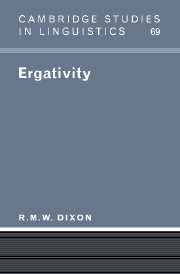Book contents
- Frontmatter
- Contents
- Preface
- Acknowledgements
- Appeal
- List of abbreviations
- 1 Introduction
- 2 Syntactically based and semantically based marking
- 3 Intra-clausal or morphological ergativity
- 4 Types of split system
- 5 The category of ‘subject’
- 6 Inter-clausal or syntactic ergativity
- 7 Language change
- 8 The rationale for ergativity
- Appendix: A note on theoretical models
- References
- Index of authors
- Index of languages and language families
- Subject index
6 - Inter-clausal or syntactic ergativity
Published online by Cambridge University Press: 06 July 2010
- Frontmatter
- Contents
- Preface
- Acknowledgements
- Appeal
- List of abbreviations
- 1 Introduction
- 2 Syntactically based and semantically based marking
- 3 Intra-clausal or morphological ergativity
- 4 Types of split system
- 5 The category of ‘subject’
- 6 Inter-clausal or syntactic ergativity
- 7 Language change
- 8 The rationale for ergativity
- Appendix: A note on theoretical models
- References
- Index of authors
- Index of languages and language families
- Subject index
Summary
Chapters 3 and 4 dealt with intra-clausal or morphological ergativity, relating to ways in which S and O are marked in the same manner, and A in a different manner, within a single clause. It is now time to consider what happens when two clauses are linked together in a coordinate or subordinate construction. In some languages there are syntactic constraints on clause combination, or on the omission of coreferential constituents in clause combinations. If these constraints treat S and O in the same way and A differently, then the language is said to be ‘syntactically ergative’, with an S/O pivot; if they treat S and A in the same way and O differently, then it is said to be ‘syntactically accusative’, with an S/A pivot. (In some languages the syntactic pivot may have a further function, relating to syntactic processes within a clause, such as the questioning of an NP; this will be discussed in §6.3.)
Preliminary exemplification was given in §1.2 for Dyirbal, which is ergative at the inter-clausal syntactic level and works in terms of an S/O pivot. Two clauses may only be coordinated in Dyirbal if they have a common NP which is in S or O function in each clause; the occurrence of this NP in the second clause is then generally omitted. We also mentioned that English works in terms of an S/A pivot – if two clauses that are coordinated have a common NP this can only be omitted from the second clause if it is in S or A function in each of the clauses (we can say Father returned and saw mother but not *Father returned and mother saw).
Information
- Type
- Chapter
- Information
- Ergativity , pp. 143 - 181Publisher: Cambridge University PressPrint publication year: 1994
